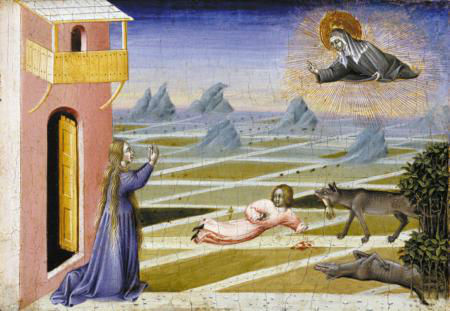Franciscans, Dominicans take center stage in exhibit on Renaissance
NASHVILLE, Tenn. (CNS) -- A Nashville museum's groundbreaking exhibit of Italian art created between 1250 and 1550 explores the significant role of the Dominicans and Franciscans in the revival of the arts that began in Italy in the 13th century.
"Sanctity Pictured: The Art of the Dominican and Franciscan Orders in Renaissance Italy" opened Oct. 31 at the Frist Center for the Visual Arts and will be on display until Jan. 25.
It is the first major presentation of Italian Renaissance art in Nashville since 1934, and represents a dream come true for Trinita Kennedy, the center's curator and a Renaissance art historian.
"This exhibition was work that I had mentioned doing when I was interviewing for the job seven years ago," said Kennedy, a parishioner at St. Philip Church in Franklin. "So this one has been a long time in the making."
Visitors to the Frist Center's website, http://fristcenter.org, can listen online to an audio tour of the exhibit and will find a Spanish-language video about it and other resources.
Kennedy's original idea was to focus on the art of the Franciscans. As she delved deeper into the subject, she was unable to find much research concerning the art of the Dominicans and the Franciscans during this period.
She said both orders created art -- frescoes, illuminated manuscripts, panel paintings, prints and sculptures -- as a vehicle for communicating their respective theologies to the general public. But there were significant differences too.
"And when you have something to compare and contrast then you can see better what is unique about each one," Kennedy told the Tennessee Register, newspaper of the Nashville Diocese. "Adding the Dominicans to the exhibit also allowed me to increase the number of potential loans for the exhibit."
As it turned out, 28 American museums and libraries, including the Art Institute of Chicago, the J. Paul Getty Museum, the Metropolitan Museum of Art, the National Gallery of Art and the Pierpont Morgan Library lent work to the exhibition. And, for the first time in its history, the Frist Center is borrowing works from the Vatican Library and Vatican Museums.
"It's a very big deal for us to be borrowing from the Vatican, and we're thrilled that they said yes," Kennedy said. "This is a very rare opportunity to see some works of art from the Vatican that have never traveled to the United States before.
"Even if somebody hopped on a plane today and went to the Vatican, they'd have a very difficult time gaining entry to the library. You have to prove that you're a scholar and that you have serious research to do, and that you're qualified to be there."
Displayed throughout five galleries, "Sanctity Pictured" encompasses more than 60 items, including paintings, manuscript illuminations, bronze medals and printed books. Among the highlights are the Vatican Museums' "St. Francis With Four Post-Mortem Miracles"; the J. Paul Getty Museum's Abbey Bible and a painting of "St. Catherine of Siena Receiving the Stigmata"; and the Allen Memorial Art Museum's "Madonna and Child With St. Francis."
To enhance the impact of the illuminated choir books, the Frist Center invited two Nashville choirs, the Dominican Sisters of St. Cecilia and the male a capella group Schola Pacis -- which got its start at Christ the King Church -- to record 13th-century chants for the exhibition's audio guide. The Dominican sisters were recorded in the chapel at their motherhouse in Nashville; Schola Pacis, at Music Row's Ocean Way Recording Studios.
"We loved making a musical connection with the art, especially with Nashville being Music City," said Kennedy. "Quite a few of the manuscripts in the exhibition are choir books, or pages from choir books. There are even some really wonderful representations of Dominicans and Franciscans singing."
"Sanctity Pictured" is accompanied by a 244-page fully illustrated, hardback catalog, which consists of essays and in-depth entries for each of the featured works. Contributors include Kennedy; Donal Cooper of the University of Cambridge; Holly Flora of Tulane University; Amy Neff of the University of Tennessee, Knoxville; and Janet Robson, an independent scholar.
The Frist Center is offering a variety of activities associated with the exhibit, including an all-day symposium Jan. 10 featuring several of the experts whose writings appear in the catalog; weekend children's programs, featuring an original story about St. Francis and the animals; and a showing of the 1950 film "The Flowers of St. Francis" film by Roberto Rosellini, which starred actual Franciscan friars.
The Frist is reaching out to Catholic churches in the five states closest to Tennessee to make people aware of the exhibit and related events.
But Kennedy hoped Catholics and non-Catholics alike would find a reason to see the once-in-a-lifetime exhibition.
"Everybody loves Francis, and he's definitely one of the superstars of our show!" she said. "He has this universal appeal with being the patron saint of animals, and of the environment. ... Right across from the Frist Center is a church that hosts the blessing of the animals every year, and it's not even a Catholic church."
"We do hope that Francis brings people in, but we've also tried really hard to bring in beautiful examples of Renaissance art," continued Kennedy. "So hopefully on that level people can appreciate it."
- - -
Solomon writes for the Tennessee Register, newspaper of the Diocese of Nashville.



















